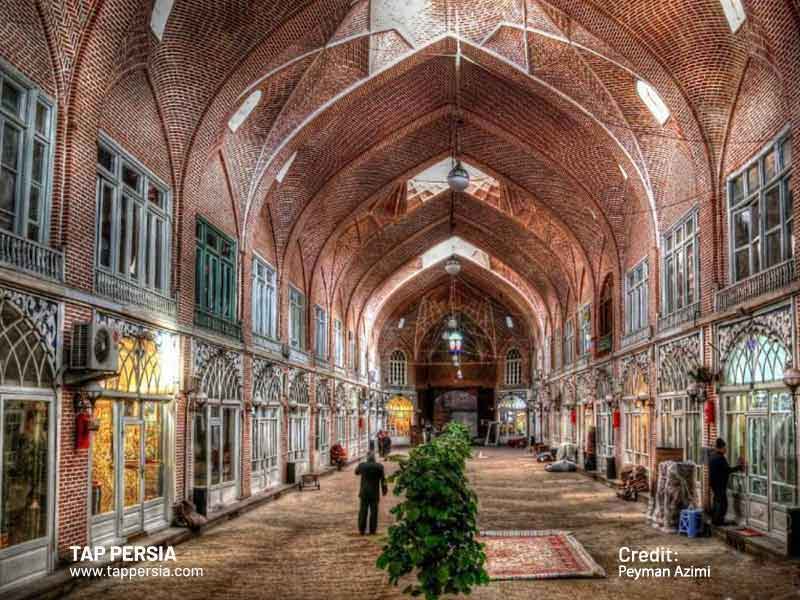 Tabriz, located in the northwest of the country, is one of Iran’s tourism hubs. This city hosts valuable heritage with its rich historical and cultural background. Also, due to its geographical location, it has various natural attractions(Tabriz historical places). In 2018, Tabriz was introduced as a model city for tourism in the Islamic world. This metropolis welcomes many domestic and foreign tourists throughout the year. Together, we are going to learn more about the Tabriz Grand Bazaar in this gorgeous city.
Tabriz, located in the northwest of the country, is one of Iran’s tourism hubs. This city hosts valuable heritage with its rich historical and cultural background. Also, due to its geographical location, it has various natural attractions(Tabriz historical places). In 2018, Tabriz was introduced as a model city for tourism in the Islamic world. This metropolis welcomes many domestic and foreign tourists throughout the year. Together, we are going to learn more about the Tabriz Grand Bazaar in this gorgeous city.
Tabriz Bazaar Features
Roofed market of Tabriz with an area of more than one square kilometer is the largest interconnected brick complex in the world. It consists of 5,500 cells, 20 rows, 25 timchehs and 35 houses, schools, baths, mosques and caravanserais.
The sections together shine like a gem among Iranian traditional Bazaaars. This bazaar, which is considered one of Tabriz’s attractions, was included in the list of National Heritage of Iran in 1975. And in 2010 it was registered as a part of the Silk Road and the largest roofed structure in the world in the UNESCO World Heritage Sites in Iran.
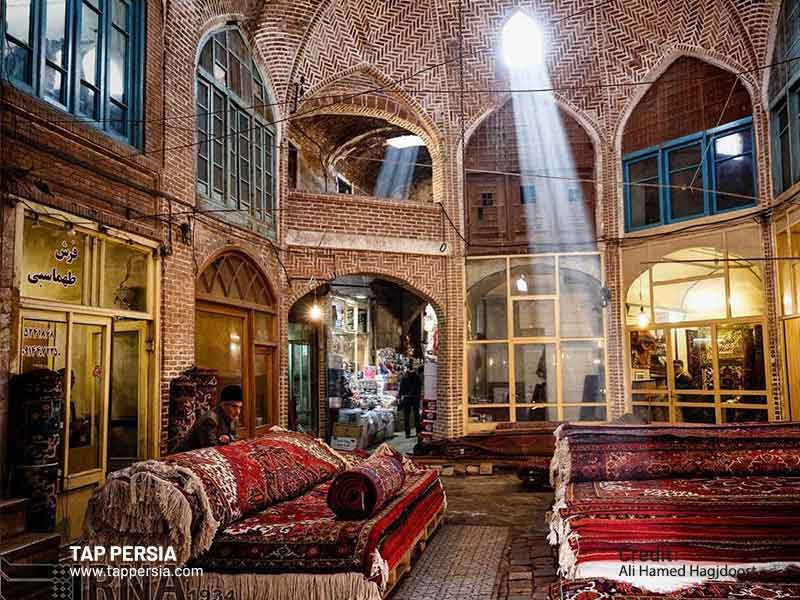
In general, the functions of Tabriz market include collection, distribution and retail. Various goods are sold in this market, the most important of which are hand-woven carpets, leather bags and shoes, herbal and medicinal products, spices, fabrics, etc., which has the atmosphere of traditional markets and includes modern devices, as well, such as mobile phones and computers.
Considering that Jame Mosque and schools such as Sadeghieh school are located in this bazaar , the economic functions of the market are sidelined during Nowruz days or Ramadan and Muharram mourning days. The market of Tabriz is covered in black with the arrival of Muharram, and most of the bazaars close their shops from the 8th to the 12th of this month.
As the main center of mourning, Timcheh Mozafaria receives the largest number of mourning groups. Along with mourning, the people of the bazaar distribute offerings such as tea, dates, cookies, etc. among the Hosseini mourners. The ritual of mourning in the market of Tabriz is registered in the list of national rituals.
Tabriz market is not only one of the tourist attractions of East Azarbaijan province, but also a rare example of bazaars in cold regions in Iran. And unfortunately, it has been neglected in recent years and, in addition to the wear and tear of urban facilities, high-quality equipment has not been installed in it. This gradual erosion leads to a decrease in the social and economic function of the bazaar, which will continue if the authorities continue to ignore it.
Bazaar of Tabriz Location
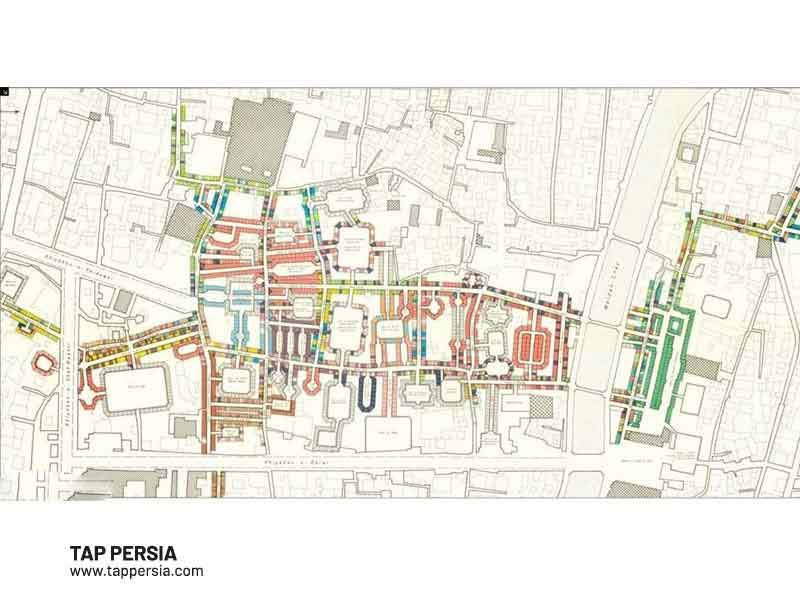
Tabriz bazaar overlooks Jame Mosque from the west and leads to Ali Qapu from the east and parts of Maidan Chayi River from the north. A large part of the bazaar area is located in the south of Chay square and in the distance between Shohada, Darayee, Chaykenar, Ferdowsi, Shahid Motahari and Jomhuri Eslami streets.
History of Tabriz Bazaar
Before Qajar Era
The age of Tabriz bazaar is not exactly known; However, many world travelers from Ibn Battuta and Marco Polo to Yaqut Hamavi, Gaspard Droville, Jean Chardin, Jamli Cardi, Hamdullah Mostofi, etc., who visited it from the fourth century AH to the Qajar era, in addition to praising this place, they have documented it in their books or writings.
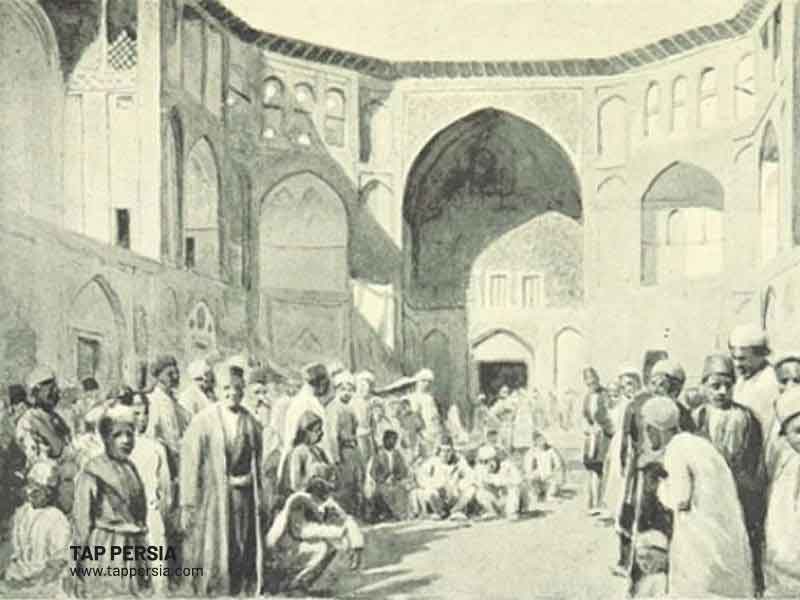
Since the city of Tabriz was located on the route of the Silk Road, as a result, many caravans from different parts of the world passed through it. Tabriz bazaar was very prosperous and was considered one of the most important trading centers of that time. It was so important that the gates of this bazaar were considered as the main gates of the city.
There are paintings from the Seljuk era, according to which there was a bazaar in the current location of the Bazaar Bozorg-e Tabriz, which became very famous during the Ilkhanid era. And when Tabriz was chosen as the capital, this prosperity continued until the Safavid period. It was so that many came to this market from different cities for trading.
It is good to know that during its long history, the Tabriz grand Bazaar has gone through various events such as destructive earthquakes (earthquake of 1193 AH) and has been renovated and restored every time. In fact, the current market of Tabriz dates back to the end of Zandiyeh and the Qajar era.
During Qajar Era
During the Qajar era, when Tabriz was located near the European markets and was considered as the Crown Prince’s city, the prosperity and importance of the market was maintained and it continued to play the role of the main connection for Iran’s exports to Europe.
So that in the 13th century and coinciding with the period of Abbas Mirza, the Qajar crown prince, it became a famous commercial center where English traders used to reach the market of Tabriz through the Silk Road.
The volume of exchanges in this period reached such a level that about 30% of Iran’s business dealings were done in Tabriz market. During the reign of Abbas Mirza, in addition to the construction of his complex of palaces known as Ali Qapu in the east of the bazaar, they built many palaces and timchehs, as well.
In addition, the historical mosques and schools such as Jame Mosque, Sadeghieh School and Haj Safar Ali School confirm the historical background of this complex.
From mirrors and all kinds of fabrics to glass, sugar, metal, etc., were the majority of European goods imported to Iran. Goods such as silk, tobacco, dry fruits, shawls, oak apple and wax were also sold to Europeans in this market.
Tabriz Bazaar Architecture

Tabriz Bazaar is built in such a way that its outer part is in harmony with the urban fabric and resembles normal buildings. In addition, the importance of Tabriz bazaar is not only related to its size, but it is important in terms of the mastery of architects in using bricks and brick pottery, which has created diverse spaces.
One of the interesting features of this bazaar is the vents in the center of its arches that allow hot air to escape; In addition, there are no valves installed in some parts of the market so as not to cause wind flows. The thick walls of this structure also preserve heat in winter.
Due to the rain and cold weather in Tabriz, the market rows have been made covered. In addition, the height of its roof reaches 5 to 6 meters, which is shorter than the markets in tropical parts of Iran in order to maintain the heat. While walking in this market, you will see that the rows are about four to five meters wide and are in the north-south direction.
Important Sights of Tabriz Bazaar
Timcheh Mozafariyeh, Amir Serai , Tabriz Jame Mosque, Talebiyeh School, Khan Hamam Imamzadeh Jamal, Tabriz Bazaar Museums, Zoorkhaneh Garshasb-e Yal, and Haj Ali Restaurant are the places you should not miss while visiting this grand bazaar.
Is It the World’s Largest Roofed Bazaar?
When you research Tabriz Bazaar in various sources and websites, you come across the fact that this market is the largest covered market in the world, a feature that makes it very distinctive and attractive. But in our research, we also came across the fact that Grand Bazar Istanbul is famous in some sources as the oldest and largest indoor market in the world.
Anyway, a review of the English Wikipedia websites of two markets in Istanbul and Tabriz shows that the Grand Bazaar of Istanbul is known as one of the largest covered and old markets in the world, and the Tabriz market is the largest covered market in the world. Also, in the articles written by the reliable Guardian newspaper about both bazaars, the Tabriz bazaar is mentioned as the largest roofed bazaar in the world, but the Istanbul Grand Bazaar is one of the largest covered bazaars in the world.
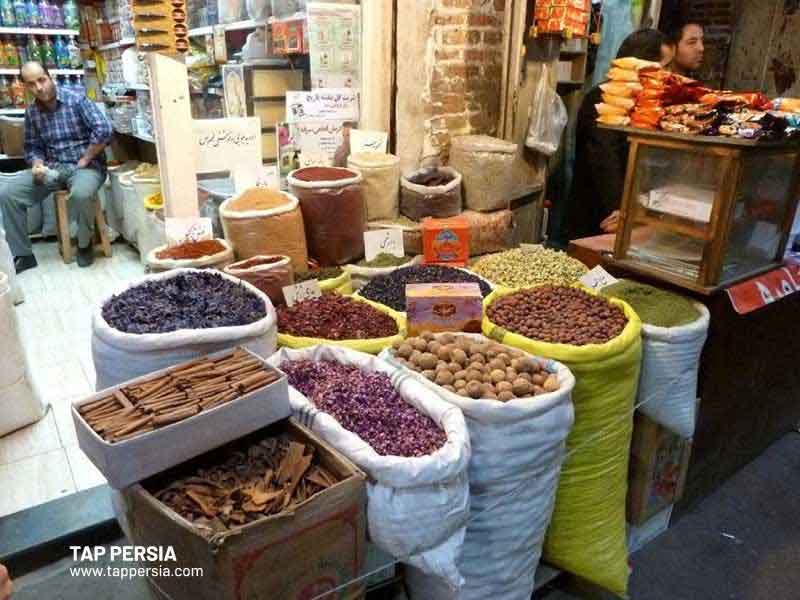
Where to Eat near Bazaar of Tabriz
Here are a list of the best places to eat around Bazar Bozorg-e Tabriz:
- Urban Cafe: Valman Street
- Baliq Restaurant: Nowbar Street
- Tabriz Modern Restaurant: Near to Shariati Square, Emam Kh St, Tabriz
- Berkeh Restaurant: Ring road of Sardroud
- Haj Ali CheloKababi: Tabriz Bazaar
- Delestan Restaurant and Fast Food: Front of JamJam – 29 Bahman Street
- Shazdeh Restaurant: no 111, entrance of Small Dallaleh Zan, Sadegheh Bazar
- Barcode Restaurant and Cafe: Ghanun St. Inside Jazireh Complex
- Unlu wine and Dine: Tabriz Khalil Rza, 40
- Good Fish: North Shahriar, Valiasr
Where to Stay Near Bazaar of Tabriz
And Here are some hotels around Bazaar that you can stay:
- Tabriz International Hotel: Emam St, University Circle, Tabriz, Iran
- Gostaresh Hotel: Abresan Avenue, Tabriz 12454, Iran
- Morvarid Hotel: Bagh Golestan Square, Tabriz, Iran
- Hotel Behbood Tabriz: No 9, after North Garden Crossroads, Shoaar Alley, Tabriz, Iran
- Shahryar International Hotel Tabriz: El Goli St., Shahid Bakeri Blvd., Tabriz, Iran
- Tabriz El-Goli Pars Hotel: El Goli Str, Tabriz, Iran
- Laleh Park Hotel: Pasdaran Runway Shahid Fahmideh Sq., Tabriz 360025, Iran
- Darya Hotel : 22 Bahman Ave, Tabriz, Iran
How To Get To Bazaar of Tabriz
Address: East Azarbaijan Province, Tabriz, Tabriz Grand Bazaar
Tabriz Bazaar has entrances from different parts of the city. You can reach this market from Rasteh Kocheh, Jomhuri, and Darayee streets.



Comment (0)